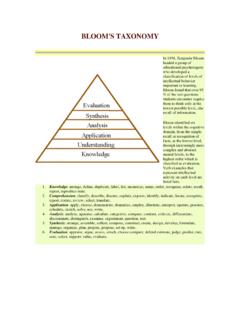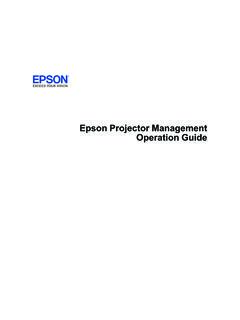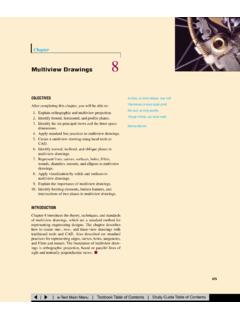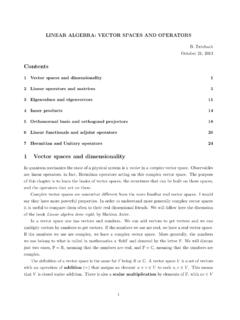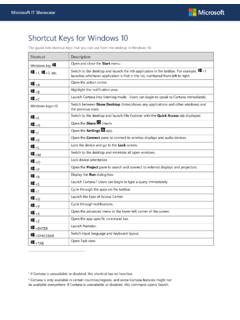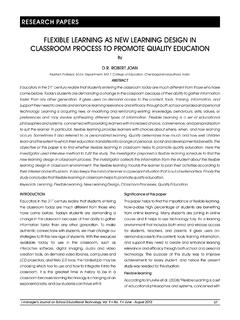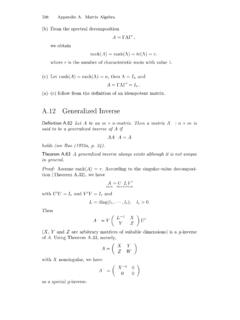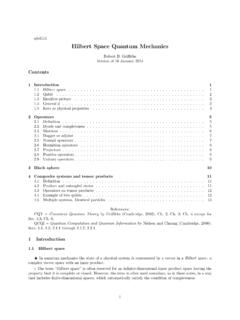Transcription of What Resolution Should Your Images Be?
1 1 What Resolution Should Your Images Be?The best way to determine the optimum Resolution is to think about the final use of your publication you ll need the highest Resolution , for desktop printing lower, and for web orclassroom use, lower still. The following table is a general guide; detailed explanations SizeResolutionPreferredFile FormatApprox. FileSizeProjected in classAbout 1024 pixels widefor a horizontal image; or768 pixels high for avertical one102 DPIJPEG300 600 KWeb siteAbout 400 600 pixelswide for a large image;100 200 for a thumbnailimage72 DPIJPEG20 200 KPrinted in a bookor art magazineMultiply intended printsize by Resolution ; animage to be printed as 6 W x 4 H would be 1800x 1200 DPIEPS or TIFF6 10 MBPrinted on alaserwriterMultiply intended printsize by Resolution .
2 Animage to be printed as 6 W x 4 H would be 1200x 800 DPIEPS or TIFF2-3 MBDigital Camera PhotosDigital cameras have a range of preset resolutions which vary from camera to Image size at300 DPIP rintable size ona color printer4 Megapixels2272 x 1704 x 12 x 9 3 Megapixels2048 x 1536 x 5 11 x 2 Megapixels1600 x 1200 x 4 6 x 4 1 Megapixel1024 x 768 x 5 x 3If you can, you generally want to shoot larger than you need, then sharpen the image and reduceits size in Screen: Classroom Use and Web Images that will exist only on screens, it s better to think in terms of pixel dimensions classroom use, the guiding factor is the presentation equipment.
3 Your monitor might be ableto show 1800 x 1440 pixels, but you won t be able to project that. The Hitachi CP-X430 Wprojectors we have installed in the Schermerhorn classrooms project an image of 1024 x 768pixels (what s known as XGA Resolution ). This is pretty standard for high-end digital projectorsthese days. Any image you re showing that s larger in pixel dimension will be resampled downby the projector. So if you re saving an image for use in the classroom, there s no need tomake it much larger than 1024 pixels wide. (Of course if you re going to zoom in on a detail ofthe image, you d need it that much larger.)
4 If you use PowerPoint to project your Images , you might notice that a 1000 pixel wide imagelooks tiny on the PowerPoint workspace (or perhaps unexpectedly large). That s becausePowerPoint measures its Images according to the Document Size, not the Pixel Dimension asPowerPoint is made to work at the highest Resolution possible for whatever device will ultimatelydisplay the slide show. (See below for more about Document Size and Pixel Dimensions.) ThePowerPoint slide is 10 wide and high. So an image with a Document Size of 10 x anda Resolution of 50 PPI will fill your PowerPoint screen, but when it s projected it ll look fuzzy (inpixel terms, that image is only 500 x 375 pixels).
5 Conversely, if you have an image that s 4 x 3 at 300 PPI it will import into PowerPoint as rather a small image on the 10 x field, butsince the image is actually, 1200 x 900 pixels you could scale it up to the full width of thePowerPoint slide without any loss in image quality when it s projected. (You could think of it asthe projector having an effective Resolution of about PPI.)It s best to look at the pixel dimension of your Images as you re making them. As long as they reat least about 1024 pixels wide (for a horizontal image) they Should be fine for standard Resolution for web Images is 72 PPI (often called screen Resolution ).
6 At that size,the pixels you see on the screen are all the pixels there are; an image that s 4 long at 72 PPI willtake up about 4 of your monitor. (Obviously there ll be a lot of variation here, as most monitorshave a range of resolutions they can be set at.)Most web sites are built to be visible on many different kinds of monitors. Usually a web sitewould be about 700-800 pixels wide. That means an image that s about 400 or 500 pixels widewill take up a good chunk of the web page, and look pretty big on a monitor. You might want abigger image on your site, but remember, some users might only have screens that show 800 x600 Print: The dot and the bit about printing: Images are printed using a halftone screen, made up of a mesh of tiny spotsof varying sizes.
7 In the old days, these patterns were formed by exposing a photograph throughscreens etched on glass, which were measured by counting the number of parallel lines to theinch. Thus the traditional measurement for the Resolution of a printed image is still lines perinch or halftone image Images are generally printed with a very coarse screen, about 90 LPI. Magazines areusually printed with a 133-150 LPI screen, and book illustrations at least 150 LPI. Photo qualityink-jet printers print at the equivalent of about 133-150 LPI, and most laserwriters can handleabout a 100 LPI Images are usually measured by counting the number of individual pixels (dots of imagedata) in an inch.
8 Thus he Resolution of digital Images is often given in Dots per Inch (DPI) or,more precisely, Pixels per Inch (PPI).[The terminology gets confusing as laserwriters are also measured in terms of Dots per Inch,referring to the spacing of individual dots of toner in making up solid forms, such as letters, orhalftone spots. Since it takes a certain amount of laserwriter dots of toner to make up a halftonespot, and since the halftone spots vary in size while laserwriter dots are all the same size, a 600 DPI laserwriter can print a halftone screen of about 100 LPI.]The higher the LPI Resolution of the final image, the more image data a digital image the computer needs to create the halftone screen from the image before printing it, and ittakes more than one pixel to make a halftone spot.
9 The usual rule of thumb is: 2 pixels for everyfinal halftone spot. That is, to print something at 150 LPI halftone Resolution , you need an imageof 300 PPI. However, most image processing software can get away with less. Anything withinthe rage of to 2 times the final LPI Resolution Should be OK. So, realistically, to print animage at 150 LPI, you can use a digital image anywhere from 225 PPI to 300 PPI. (You can,of course have more image data, but it doesn t give you any better a final result, and just takes upextra disk space and clogs your image processing software upon printing.)
10 Document Size and Pixel DimensionsImage editing software, such as Photoshop, can adjust many variables in your image. Some arerelative variables, and some absolute. The absolute size of the image is the Pixel Dimension. This is the number of individual little dots of color in the image. The Document Size (in inches orcm) and the Resolution (in PPI or pixels per cm) are relative to the Pixel Dimension. TheDocument Size tells you how big your image can print at the given example, if you have an image with a 6 x 4 document size at 300 PPI Resolution , you canprint that image comfortably up to 6 x 4 at 150 LPI.
